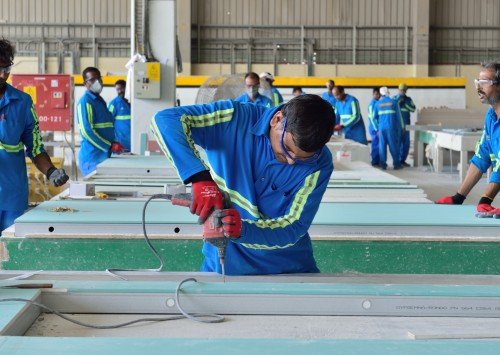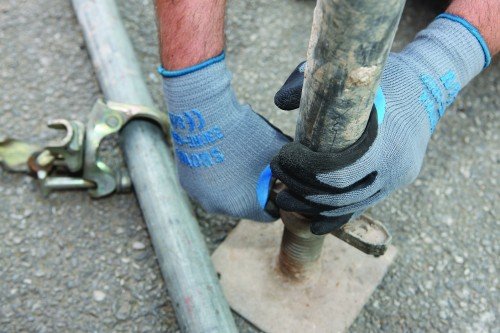Case study: hand protection and worker engagement
 Worker hand protection is a big challenge for those in the construction industry. Using a case study with Laing O’Rourke, Perry Salter, Globus, explains how proactive worker involvement can have far-reaching benefits for workers and employers.
Worker hand protection is a big challenge for those in the construction industry. Using a case study with Laing O’Rourke, Perry Salter, Globus, explains how proactive worker involvement can have far-reaching benefits for workers and employers.
Protecting workers’ hands has long been one of the biggest challenges for those responsible for managing workplace safety in the construction industry. Whilst tightening legislation, a focus on injury prevention through changed working practices and advanced materials technology, have had a positive impact, hand injuries remain a constant threat.
Of the 5000+ construction injuries reported in 2015 causing the sufferer to take more than 7 days off work, 30% were as a result of lifting and handling materials on site.
So what can organisations do to help reduce risks to workers?
Establishing an effective survey
A hand protection programme should be built with the support and engagement of workers from the outset, including taking them with you through the safety process.
They are best placed to provide invaluable insight and feedback and by making them central to decision making, you empower them to invest in their own wellbeing.
From experience we know engaged workers are far more likely to buy into the hand protection programme, wear their gloves – and keep them on – because they understand the products’ purposes and why they were selected. In turn, their support becomes part of the safety culture.
An example of the effectiveness of this approach was demonstrated when Globus worked with Laing O’Rourke on its Middle East sites to develop a hand protection programme for its 3,000 workers.
Worker engagement case study: Laing O’Rourke, Middle East
As a leading international contractor, Laing O’Rourke’s Middle East Division includes major commercial and residential developments across the region including the United Arab Emirates, Saudi Arabia and Qatar.
As a family-owned business with strong corporate social responsibility values, Laing O’Rourke’s directors wanted to ensure their 3,000 glove-wearing workers were valued and motivated.
The company had been using gloves from a supplier for almost three years but were suffering from supply consistency issues. Wider issues had been identified as hand protection solutions were being sourced for each individual project by different business units within the organisation.
The result was operatives carrying out the same task on separate project sites who, potentially were wearing completely different gloves. There was also inconsistency with glove quality and generally gloves were being worn and discarded quickly.
 The solution
The solution
Globus was invited in to Laing O’Rourke Middle East to help address the issues.
Worker engagement was identified as a critical step in the success of the programme from the outset. As a result, Globus, carried out product evaluation trials across five areas of the business making worker feedback a core element of this.
Having reviewed the tasks carried out on sites, a range of SHOWA and SKYTEC gloves were selected to reflect the hazards encountered. By standardising the selection for each task right across the company Laing O’Rourke could ensure greater consistency and greater quality whilst improving hand protection across its sites.
This method had already worked well for Laing O’Rourke in the UK, and the Middle East construction company wanted to emulate the success of the UK.
Having been instrumental in the glove selection process through the initial trials, workers were reporting a range of benefits including greater protection from both environmental and task related risks in addition to enhanced grip, control, durability and comfort compared to the previous hand protection provided.
To reinforce the gloves selected, employee training packages, education and awareness campaigns, ongoing site support, posters and a clear hand protection protocol that all operatives could follow were produced.
This included translation into alternative languages to reflect the 30 different nationalities that made up the Laing O’Rourke workforce.
Conclusion
As a result of the programme, Laing O’Rourke Middle East has been able to ensure glove consistency in terms of quality, comfort and performance for each task.
The company has also seen wider benefits including 50% increase in glove lifespan. In some tasks this is as high as four times increased lifespan, with the resultant cost savings.
Although the initial cost per glove was higher than the previous solution, Laing O’Rourke achieved these significant cost savings after only four months.
In addition to supply and cost benefits, most significantly, during the first six months of the new hand protection policy zero hand injuries were reported.
Effective hand protection is not about simply meeting the minimum requirements required by law. Workers that feel valued, listened to and that are involved in the decision-making process by providing input and feedback will actively contribute to the health and safety culture. Win the hearts and minds of workers and the benefits can be felt way beyond pure workplace safety.
Not only can this approach positively impact attitudes to hand protection but it can also have wider benefits, including but not limited to:
- Increased productivity
- Increased performance
- Improved staff morale
- Reduced purchasing costs
- Lower accident rates
- Lower sickness and absence rates
- Greater awareness of workplace risks
- Greater health and safety compliance
- Reduced insurance premiums
For more information and case studies, visit the Globus website.
Case study: hand protection and worker engagement
Worker hand protection is a big challenge for those in the construction industry. Using a case study with Laing O’Rourke,
Safety & Health Practitioner
SHP - Health and Safety News, Legislation, PPE, CPD and Resources Related Topics
The guardian angel when working alone
Global Handwashing Day: Employees urged to make time to care for their skin
Four key aspects of workplace wellbeing


